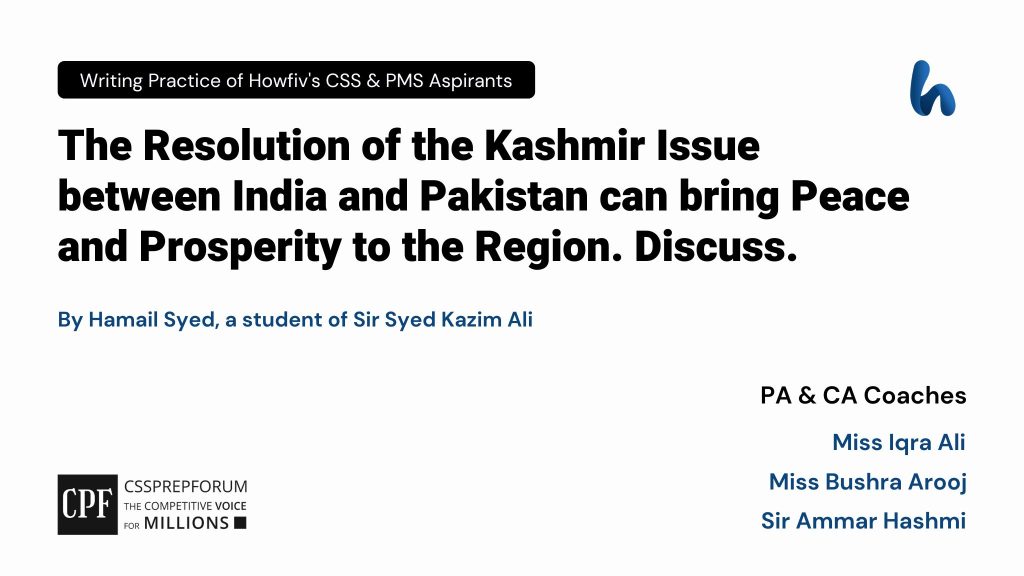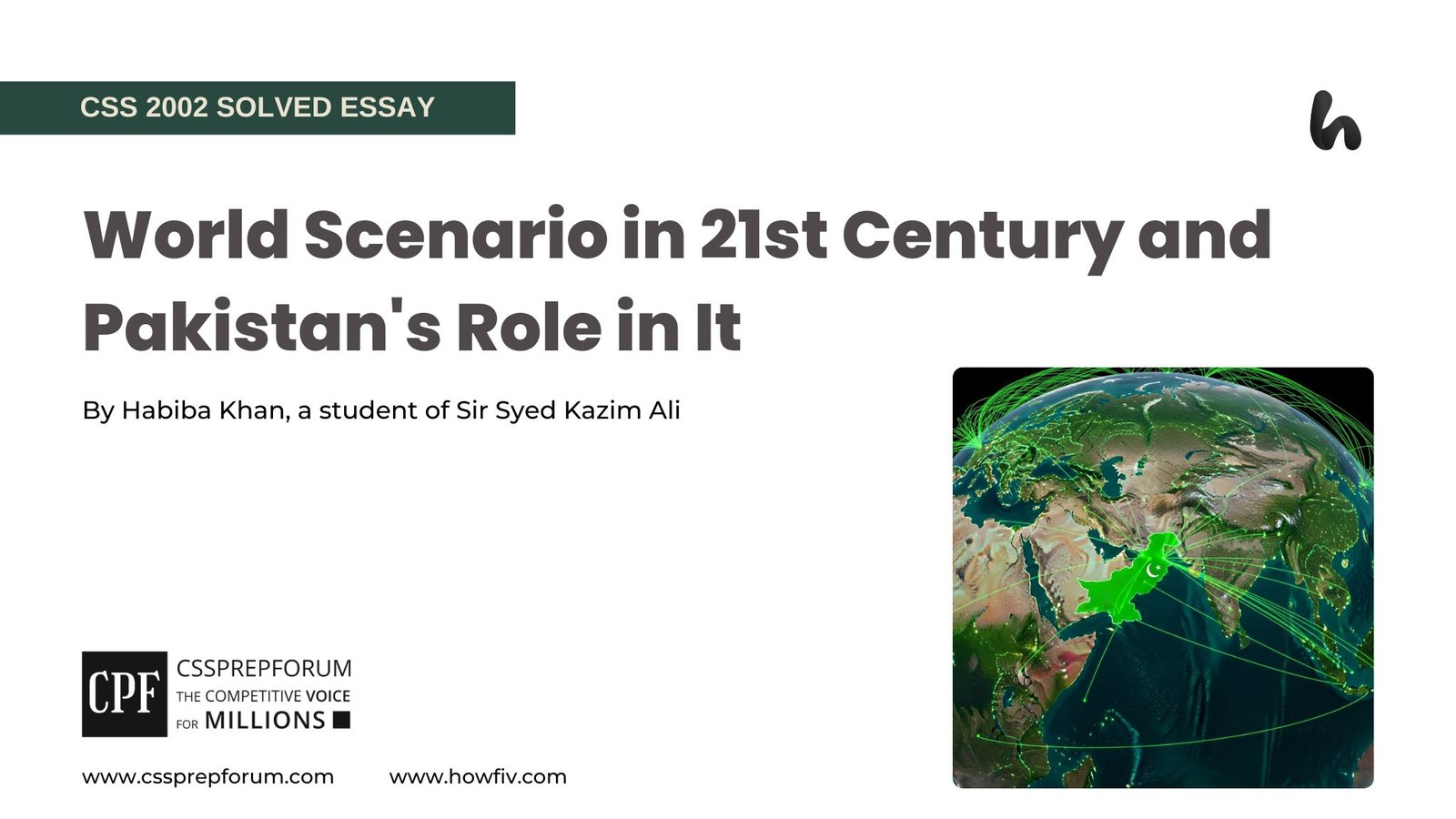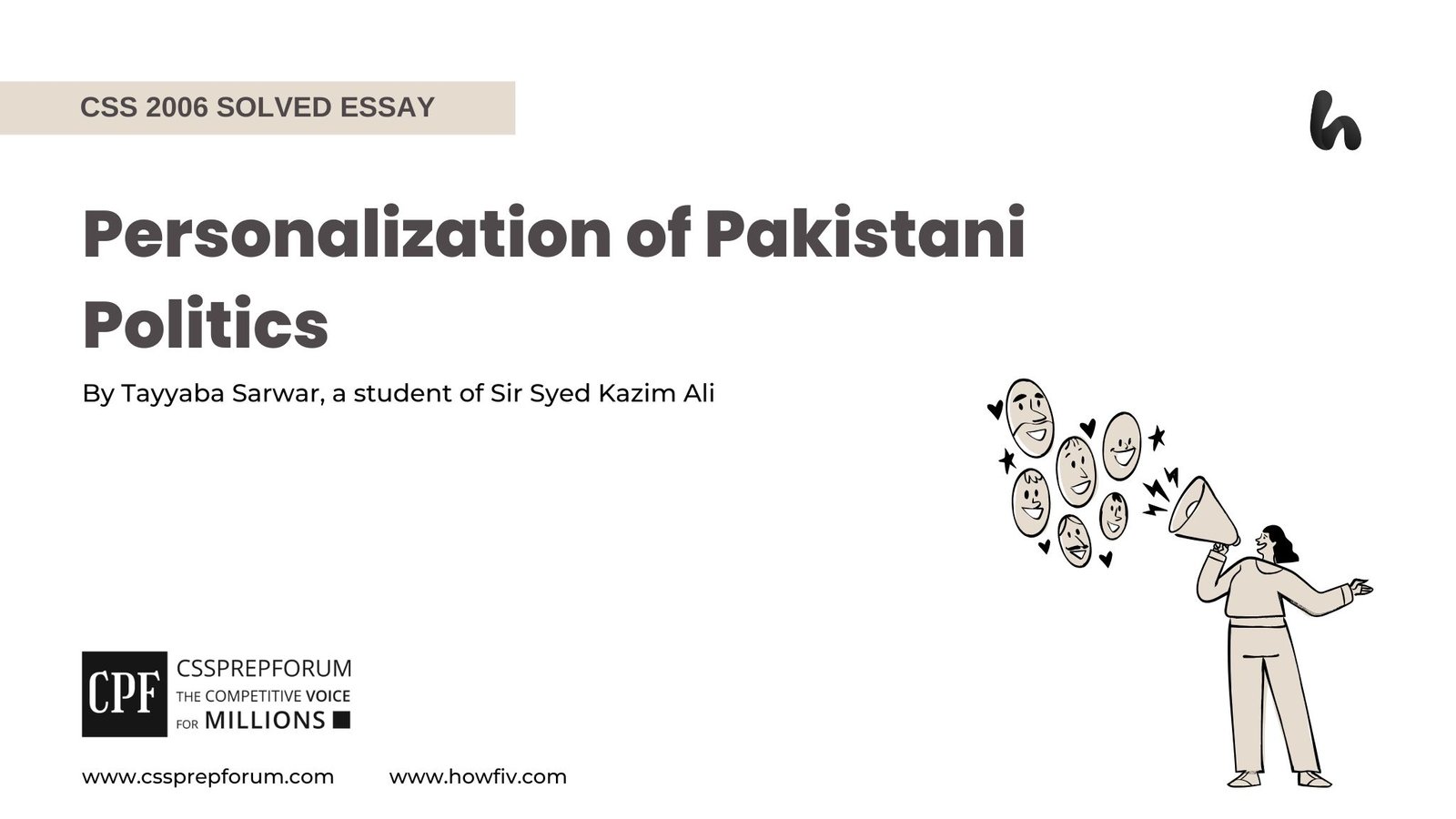CSS Pakistan Affairs | Kashmir Issue Resolution
The following question of CSS Pakistan Affairs is solved by Hamail Syed under the supervision of Howfiv’s Pakistan Affairs Coaches. She learnt how to attempt 20 marks question and essay writing from Sir Syed Kazim Ali, Pakistan’s best CSS and PMS English essay and precis teacher with the highest success rate of his students. This solved past paper question is attempted on the pattern taught by Sir to his students, scoring the highest marks in compulsory and optional subjects for years, and uploaded to help aspirants understand how to crack a topic or question, how to write relevantly, what coherence is, and how to include and connect ideas, opinions, and suggestions to score the maximum.

Outline
1-Introduction
2-A glance at the history of the Kashmir conflict between India and Pakistan
- ✓The Treaty of Accession
- ✓Inclusion of Gurdaspur to India
3-How can the resolution of Kashmir between India and Pakistan bring peace and prosperity to the region?
- ✓By decreasing the arms race between the two states
- Evidence: India tested a nuclear-capable intercontinental ballistic missile named Agni-V in 2021. Likewise, on January 20, 2021, Pakistan tested its Shaheen 3 ballistic missile.
- ✓By spending a significant portion of a country’s GDP on human development instead of military expenditures
- Evidence: According to the Institute of Strategic Studies Islamabad (ISSI) Report, 2023, “On February 1, 2023, India increased its defence budget to approximately 72.6 billion dollars, whereas Pakistan has invested 8.3 billion dollars in defence.”
- ✓By enhancing trade relationships
- Evidence: According to Michael Kugelman’s research article’ Pakistan-India Trade Relationship: Prospects, Profits, and Pitfalls, ‘ the current trade volume between India and Pakistan is less than 3 billion dollars, but it can soar to 40 billion dollars after trade normalization.
- ✓By ending the 5th generation of warfare
- Evidence: In 2019, EU DisinfoLab, a Brussels-based disinformation watchdog, cracked open a massive 15-year-old Indian operation targeting international institutions, including the United Nations (UN) and the European Union (EU), with over 750 fake local media outlets and more than ten dead NGOs to serve Indian interests and amplify content to undermine Pakistan.
- ✓By granting fundamental human rights to Kashmiris
- Evidence: According to the Amnesty International Report, 2020, “The people of Jammu and Kashmir have been facing grave abuse of their rights for decades, which includes unlawful killings and arbitrary detentions. The situation only worsened for them after the abrogation of Article 370 in 2019.”
- ✓By enabling SAARC (South Asian Association for Regional Cooperation) to achieve its goals
- Evidence: AK Abdul Momen, Bangladesh’s Minister of Foreign Affairs, blamed India and Pakistan’s animosity as the main reason SAARC is unprosperous.
4-Recommendations to resolve the Kashmir issue for good to bring peace to the region
- ✓Sweden-Finland Aland-Island Model
- ✓China as a mediator
5-Conclusion

Answer to the Question
Introduction
Since partition, the dispute over Kashmir has been a bone of contention between India and Pakistan. It is considered the nuclear flash point of the South Asian region, as it poses a serious threat to the region’s peace and security. Historically, India and Pakistan have fought three wars over this issue, including 1948, 1965, and 1999, since 1947. Both rivals have been engaged in border skirmishes often. Unquestionably, this conflict has triggered a nuclear arms race in the region, which can disturb peace and stability in the future. Thus, the solution is crucial at the earliest. India and Pakistan cannot move forward on the path of normalization for the region’s betterment unless the dispute is resolved. As the peace of South Asia continues to remain hostage to this dispute, the resolution of the Kashmir issue can undeniably bring peace and stability to the region. A Russian Finance Minister once said at the Davos annual economic forum that there could not be peace in the subcontinent without solving the Kashmir dispute. This fact indicates that the resolution of the Kashmir issue can ensure peace and prosperity in the South Asian Region by decreasing the arms race between the nuclear power rivals, India and Pakistan, enhancing trade relationships, ending the 5th generation of warfare, and enabling the SAARC (South Asian Association for Regional Cooperation) to achieve its goals. Thus, by resolving the Kashmir issue, the South Asian region can become a peaceful and prosperous region in which to live.
A glance at the history of the Kashmir conflict between India and Pakistan
Historically, the conflict in Kashmir could be traced back to the Treaty of Amritsar of 1846, which provided Kashmir to Maharaja Gulab Singh under British colonial rule. Further, Kashmir, as a Muslim-majority state, was ruled by Hindu Maharajas from 1846 until 1947, and the century-old Dogra rule proved unfavourable for the Muslim community in Kashmir. As a result, in 1946, the National Conference, a political party in Kashmir headed by Shiekh Abdullah, launched the ‘Quit Kashmir’ movement, asking the Maharaja to hand over the power to the people. Moreover, when Lord Mountbatten announced the partition plan in June 1947, it was declared that all Hindu majority areas would form India, Muslim areas would make Pakistan, and princely states would be given the right to choose whether to side with India or Pakistan according to religion and geographical proximity. While the Maharaja of Kashmir was delaying his decision to accession, an indigenous revolt took place in the Poonch region, which Pashtoon tribesmen later joined. At that time, Maharaja rushed to the Indian government, asking for its help to curb the revolt, and India exploited the opportunity and made him sign the Treaty of Accession. As a result, the Indian military occupied that region forcefully. Besides that, another vital cause of the Kashmir issue is the unfair division of territories under the Radcliffe Awards. For example, Cyril Radcliffe gave Gurdaspur, a princely state with a Muslim majority, to India, providing India with a road link to Jammu and Kashmir. This fact shows that the inclusion of Gurdaspur in Indian territory provided a corridor for the Indian military to reach Kashmir. It was against this backdrop that India and Pakistan fought and ended their first war in December 1947 with the intervention of the United Nations (UN) at the request of India, which instantly internationalized the Kashmir conflict right at its beginning.
How can the resolution of Kashmir between India and Pakistan bring peace and prosperity to the region?
Unquestionably, the resolution of the Kashmir conflict and the peace in the South Asian region are interlinked; therefore, the solution to this problem can bring peace and stability to the region. In this regard, various prospects of the Kashmir resolution have been discussed, ensuring regional prosperity.
- ✓By decreasing the arms race between the two states
First, the solution to the Kashmir issue can ensure peace in the South Asian region since it can decrease the arms race between Pakistan and India. Evidently, Pakistan and India have been arch-enemies since their independence from British rule. Additionally, there have been over four full-fledged armed conflicts, countless border skirmishes, and cross-border ceasefire violations between these nuclear-power neighbouring states, mainly over the Kashmir dispute. As a result, the mutual relationships between both states have often nosedived to the point where nuclear conflagration seemed like a real possibility. Indeed, both states are in a security dilemma mainly due to the Kashmir conflict, leading to an arms race. For example, India tested a nuclear-capable intercontinental ballistic missile named Agni-V in 2021. Likewise, on January 20, 2021, Pakistan tested its Shaheen-III ballistic missile. This shows that both states are engaged in a vicious cycle of arms races, destabilizing the region. Evidently, when the Kashmir issue is resolved, the arms race and the nuclear war risk may diminish, bringing peace and stability to the region. Therefore, regional peace and the solution to Kashmir are interlinked. In a nutshell, the resolution of the Kashmir conflict can bring peace and stability to the region because, after that, the arms race between India and Pakistan can come to an end, fostering cooperation between states.
- ✓By spending a major portion of a country’s GDP on human development instead of military expenditures
Second, the solution to the Kashmir conflict can promote human development in states, pulling the region out of the abyss of poverty. Basically, when countries, including India and Pakistan, are going to invest the majority of their country’s budget in economic and human development instead of military expenditures, skilled human capital may accumulate in states, bringing prosperity and stability to the region. Unfortunately, due to the non-resolution of the Kashmir issue, Pakistan and India, two developing states, invest heavily in military expenditures to maintain a balance of power, putting a strain on the national economy. As a result, the people of both states suffer economically, fighting poverty, unemployment, etc. Undoubtedly, India is the fifth-largest military spender in the world, and Pakistan spends a significant portion of its GDP on defence to neutralize Indian military gains. According to the Institute of Strategic Studies Islamabad (ISSI) Report, 2023, “On February 1, 2023, India increased its defence budget to approximately 72.6 billion dollars whereas Pakistan has invested 8.3 billion dollars in defence.” This fact signifies that both countries have invested huge amounts of resources in military expenditures, as they both went to three wars over the Kashmir conflict, disrupting the peace in the region. However, the resolution of the Kashmir dispute can eliminate the security dilemma, and Pakistan and India may focus more on human development and economic progress than on expanding military might. In this way, regional peace can be attained by solving the Kashmir issue.
- ✓By enhancing trade relationships
Third, healthy trade relationships between nations are one of the most vital aspects ensuring the region’s peace. Therefore, after the resolution of the Kashmir dispute between the nuclear-powered nations, trade relations between the two rival nations would be normalized. Further, both nations can climb the ladder of success by generating handsome revenue and tapping their geographical boundaries’ full potential, thereby allowing the South Asian states to form an economic corridor. According to the research article’ Pakistan-India Trade Relationship: Prospects, Profits, and Pitfalls’ by Michael Kugelman, “The current trade volume between India and Pakistan is less than 3 billion dollars, but it can soar to 40 billion dollars after the trade normalization.” This fact indicates that South Asian countries, like India and Pakistan, can come out of the vicious cycle of debt traps, poverty, and economic crises if they resolve the Kashmir conflict, leading the region towards peace and stability. As a matter of fact, the trade relationship between India and Pakistan has been halted since 2019 when India revoked Articles 370 and 35-A of the Indian Constitution. Due to this border conflict between the two nations, the South Asian nations cannot form an economic corridor, bringing instability and poverty to the region. Moreover, due to the rivalry between Pakistan and India, India rejected the proposal of inclusion in the One Belt and One Road initiative, undermining the economic corporations among the states. Indeed, by resolving the Kashmir dispute, the two states can indulge in a vacuous cycle of economic cooperation, boosting trade on both sides, and, ultimately, bringing the region’s peace and stability.
- ✓By ending the 5th generation of warfare
Fourth, the resolution of the Kashmir dispute can end the 5th generation of warfare between Pakistan and India, bringing peace and stability to the region. Basically, India is using 5th-generation warfare, the spread of misinformation and propaganda with the help of the media and artificial intelligence, to tarnish the reputation of Pakistan in the world. Moreover, India has used its influence in the international media to disseminate false information about Pakistan, tarnishing the positive image of Pakistan at the global level. For example, in 2019, EU DisinfoLab, a Brussels-based disinformation watchdog, cracked open a massive 15-year-old Indian operation targeting international institutions, including the United Nations (UN) and the European Union (EU), with over 750 fake local media outlets and more than ten dead NGOs to serve Indian interests and amplify content to undermine Pakistan. This fact shows that India is working towards its evil objective of damaging Pakistan’s reputation abroad. Indeed, Pakistan’s worldwide reputation has been seriously injured by India’s diplomatic efforts and negative media campaigns; consequently, Pakistan has been added to the FATF’s grey list. Further, if the Indian efforts are successful, Gwadar and the CPEC would be significantly impacted, crippling not only the economic prosperity of Pakistan but also the peace in the region. However, this 5th generation of warfare between the two states can be halted by resolving the Kashmir issue. After 75 years of border conflict resolution, India may end its rivalry with Pakistan, and both nations can be integrated socially and economically, making the region peaceful and prosperous. To sum up, resolving the Kashmir issue can bring peace and stability to the South Asian region.
- ✓By granting fundamental human rights to Kashmiris
Fifth, after the solution of the Kashmir dispute, the people of Kashmir can get their fundamental human rights that the Indian government is now snatching. Unfortunately, the South Asian region, closely behind that of sub-Saharan Africa, is also one of the world’s most poverty-stricken regions. Its social indicators, such as hunger and nutrition, health and education, drinking water, and sanitation, are poor in the UN Sustainable Development Goal (SDGs) matrixes. Basically, wars and conflicts among nations are responsible for the miserable condition of the South Asian region. The wars between India and Pakistan on the Kashmir issue are the manifestation of conflicts in the region. Unfortunately, the people of Kashmir have been suffering from the atrocities of the Indian military since 1947. They are subjected to various types of torture; they are not allowed to get an education, and there are no ample health facilities for them. The people of Kashmir have been subjected to curfews, and they are unable to exercise their basic human rights. According to the Amnesty International Report, 2020, “The people of Jammu and Kashmir have been facing grave abuse of their rights for decades, which includes unlawful killings and arbitrary detentions. The situation only worsened for them after the abrogation of Article 370 in 2019.” This fact shows that in Indian Illegally Occupied Kashmir (IIOK), there have been sheer violations of human rights. However, the people of Kashmir can get their basic rights to education, health facilities, clean drinking water, and ample food and nutrition through the resolution of the Kashmir issue, bringing sustainable development to the region. Certainly, when the Kashmir issue is resolved, the people of Kashmir can get their rights; as a result, 15 million people in Kashmir can contribute to economic activities, making the region stable, prosperous, and peaceful.
- ✓By enabling SAARC (South Asian Association for Regional Cooperation) to achieve its goals
Sixth, after resolving the Kashmir dispute between India and Pakistan, the SAARC, a regional organization, can achieve its goals of bringing regional cooperation and enhancing trade relationships among states. The bitter contours of India-Pakistan relations have negatively affected the overall functioning of SAARC. Due to the Indo-Pakistan rivalry since its inception, many SAARC summits got cancelled, hampering the success of the regional organization. According to Article III of the SAARC Charter, “The Heads of State or Government shall meet once a year.” However, this provision is more honoured in its breach than its observance. According to the research article ‘SAARC Summits 1985-2016: The Cancellation Phenomenon’ by Dr. Manzoor Ahmed, “SAARC has held only 18 Summits in the last 31 years since its inception in 1985.” This fact indicates that many SAARC summits got outright cancelled, as India cancelled the 2016 SAARC summit that was going to be held in Islamabad. Moreover, AK Abdul Momen, the Minister of Foreign Affairs of Bangladesh, blamed India and Pakistan’s animosity as the main reason why SAARC is unprosperous. This fact signifies that conflicts like the Kashmir dispute impede the progress of SAARC and the regional organization, undermining the region’s development. On the flip side, the resolution of the Kashmir issue can bring India and Pakistan closer to each other; as a result, both nations can play their role in achieving success through the regional platform, SAARC, rather than blaming each other for terror activities. When SAARC plays its role in making collective progress, the energy crunch, poverty, and economic crisis of South Asian countries could be resolved by utilizing the full potential of trade agreements such as SAPTA (SAARC Preferential Trading Agreement). Hence, in this way, the Kashmir resolution can bring peace and stability to the region.
Recommendations to resolve the Kashmir issue for good to bring peace to the region
The conflict between Pakistan and India has expanded to a vast level, yet it can be resolved if tackled sagaciously. Some possible solutions to the Kashmir problem are discussed below.
- ✓Sweden-Finland Aland-Island Model
To begin with, it is imperative to resolve the main conflicting point, the Kashmir dispute between India and Pakistan, to make the region peaceful and stable. In this setting, the Sweden-Finland-Aland-Island Model presents a glaring example of the possible solution that can be applied to Kashmir, bringing peace and prosperity not only to the people of Kashmir but also to the people of South Asia. Basically, Swedish nationals in Finland controlled the island. They wanted to unite it with Sweden, but Finland did not let them do so. With the League of Nations appointed as an arbitrator in 1921, the island was an autonomous territory. Finland retains nominal sovereignty over the island with an obligation to ensure linguistic rights (Swedish language) and the culture and heritage of Aland residents. Moreover, the island enjoys a neutral and demilitarized status; it has its flag, postage stamps, and police force. It is pertinent to highlight that Aland joined the European Union voluntarily in 1994. Conclusively, Aland is a self-governing entity that manages the conflicting interests of rival communities. Such a model, giving self-governing authority to Kashmir, should be adopted to resolve the dispute. Thus, this border conflict can be resolved between the two nations by giving autonomous status to Kashmir.
- ✓China as a mediator
Next, China can play a role as a mediator in solving the Kashmir conflict between India and Pakistan, as China aims to integrate the world economically. Certainly, only a superpower country can resolve the Kashmir dispute between India and Pakistan by acting as a mediator. Currently, the United States (US), the superpower, cannot act as a mediator to resolve this conflict because it uses India, a major ally of the US, to counter China’s influence in the region. This is why India became the first major country in South Asia to reject the Chinese vision of the Belt Road Initiative (BRI). Hence, the US, being a superpower, will never condemn the human rights abuses conducted by India in Kashmir. Unlike the US, China wants peace in the region to succeed in its BRI program. In addition, peace and stability in the region are undermined as terrorism and extremism have surged mainly due to the Kashmir dispute. Undeniably, without the resolution of the Kashmir dispute, peace in South Asia will be a distant dream. Thus, China can become a mediator in the Kashmir dispute after becoming a global power and finding the solution to this thorny issue because China prefers peace over everything else.
Conclusion
Conclusively, the conflict in Kashmir between India and Pakistan is undoubtedly a major obstacle to promoting regional integration as well as bringing peace to South Asia because, due to this issue, both countries have been indulged in a never-ending cycle of arms race and violence. In this regard, mistrust and animosity keep spiraling, manifesting in long-drawn, low-intensity conflicts between the two states. Besides that, the Kashmir conflict hinders the South Asian Association for Regional Cooperation (SAARC) in achieving its goals. The conflict is also responsible for the nuclearization of South Asia. Certainly, the Kashmir issue is a severe threat to the security of South Asia. In a nutshell, the largest problem in Kashmir between India and Pakistan is like a time bomb that can bring unlimited sorrow and suffering to the people of the region. Undoubtedly, regional peace and the Kashmir issue are interconnected. Further, the resolution of Kashmir can bring prosperity to the South Asian region by decreasing the arms race, the security dilemma, 5th generation warfare, enhancing trade relationships and enabling the SAARC to achieve its goals, ultimately making the region peaceful and stable.

CSS Solved Past Papers’ Essays
Looking for the last ten years of CSS and PMS Solved Essays and want to know how Sir Kazim’s students write and score the highest marks in the essays’ papers? Then, click on the CSS Solved Essays to start reading them.
CSS Solved Essays
CSS Solved General Science & Ability Past Papers
Want to read the last ten years’ General Science & Ability Solved Past Papers to learn how to attempt them and to score high? Let’s click on the link below to read them all freely. All past papers have been solved by Miss Iqra Ali & Dr Nishat Baloch, Pakistan’s top CSS GSA coach having the highest score of their students. General Science & Ability Solved Past Papers












